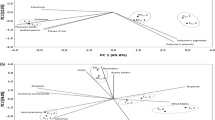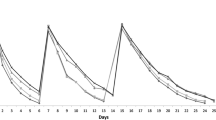Abstract
Micro-oxygenation is the controlled and continuous addition of small doses of oxygen to the wine in order to achieve a rational management of the evolution of the colour and mouthfeel properties of red wines. The short and, especially, the long-term effects of this technology on the colour characteristics of wines are still little known. In this study, a Cabernet Sauvignon wine was subjected to oxygenation treatments before (15 mg O2/L in 3 weeks) and after (6 mg O2/L in 3 months) malolactic fermentation and then aged for 20 months in barrels and/or bottles. Analysis was carried out of the dissolved oxygen concentration, the acetaldehyde content, and the evolution of several parameters related to the anthocyanic composition and the chromatic characteristics of wines for 113 weeks. The supplying oxygen significantly accelerated the kinetics of the degradation and transformation reactions of anthocyanins providing wines with a more intense bisulphite non-bleachable colour, with little or not impact on the normal evolution of their tonality. These beneficial effects produced during the treatments were kept over time, in such a way that the differences between the micro-oxygenated wines and the control wines remained after 20 months of ageing.





Similar content being viewed by others
References
Alcalde-Eon C, Escribano-Bailón MT, Santos-Buelga C, Rivas-Gonzalo JC (2006) Changes in the detailed pigment composition of red wine during maturity and ageing: a comprehensive study. Anal Chim Acta 563:238–254
Atanasova V, Fulcrand H, Cheynier V, Moutounet M (2002) Effect of oxygenation on polyphenol changes occurring in the course of wine-making. Anal Chim Acta 458:15–27
Bakker J, Timberlake CF (1997) Isolation, identification, and characterization of new color-stable anthocyanins occurring in some red wines. J Agric Food Chem 45:35–43
Bertrand A, Ribéreau-Gayon P (1970) Determination of volatile components of wine by gas-phase chromatography. Ann Falsif Expert Chim Toxicol 63:148–156
Blouin J (1992) Techiniques d’analyses de moûts et de vins, ed. Bujardin-Salleron. Paris
Boulton R (2001) The copigmentation of anthocyanins and its role in the color of red wine: a critical review. Am J Enol Vitic 52:67–87
C.I.E. (1986) Colorimetry, 2nd edn, ed. L’Eclairage CBotCId, vol 15. C.I.E., Viena
Cameira Dos Santos PJ, Brillouet JM, Cheynier V, Mountounet M (1996) Detection and partial characterisation of new anthocyanin-derived pigments in wine. J Agric Food Chem 70:204–208
Cano-López M, Pardo-Minguez F, López-Roca JM, Gómez-Plaza E (2007) Chromatic characteristics and anthocyanin profile of a micro-oxygenated red wine after oak or bottle maturation. Eur Food Res Technol 225:127–132
Cano-López M, Pardo-Mínguez F, López-Roca JM, Gómez-Plaza E (2006) Effect of microoxygenation on anthocyanin and derived pigment content and chromatic characteristics of red wines. Am J Enol Vitic 57:325–331
Cano-López M, Pardo-Mínguez F, Schmauch G, Saucier C, Teissedre PL, López-Roca JM, Gómez-Plaza E (2008) Effect of micro-oxygenation on color and anthocyanin-related compounds of wines with different phenolic contents. J Agric Food Chem 56:5932–5941
Carlton WK, Gump B, Fugelsang K, Hasson AS (2007) Monitoring acetaldehyde concentrations during micro-oxygenation of red wine by headspace solid-phase microextraction with on-fiber derivatization. J Agric Food Chem 55:5620–5625
CEE/Reglament (2679/90) Método de análisis comunitarios aplicables en el sector del vino. Diario oficial de las comidades Europeas
Escribano-Bailón T, Álvarez-García M, Rivas-Gonzalo JG, Heredia FJ, Santos-Buelga C (2001) Color and stability of pigments derived from the acetaldehyde-mediated condensation between malvidin 3-O-glucoside and (+)-catechin. J Agric Food Chem 49:1213–1217
Ferrarini R, Girardi F, De-Conti D, Castellari M (2001) Esperienze di applicazione della microossigenazione come tecnica d’affinamento dei vini. Industrie delle Bevande 30:116–122
Ferrarini R, Girardi F, De Conti D, Castellari M (2001) Esperienze di applicazione della microoddigenazione come tecnica d′affinamento dei vini. Industrie delle Bevande XXX:116–122
García-Beneytez E, Revilla E, Cabello F (2002) Anthocyanin pattern of several red grape cultivars and wines made from them. Eur Food Res Technol 215:32–37
Glories Y (1978) Recherches sur la matiére colorante des vins rouges
Hebrero E, Garcia-Rodriguez C, Santos-Buelga C, Rivas-Gonzalo JC (1989) Analysis of anthocyanis by High Performance Liquid Crhomatography-diode array spectroscopy in a hibrid grape variety (Vitis Vinifera × Vitis Berlandieri 41B). Am J Enol Vitic 40:283–291
Hebrero E, Santos-Buelga C, Rivas-Gonzalo JC (1988) High performance liquid chromatography-diode array spectroscopy identification of anthocyanins of Vitis Vinifera variety Tempranillo. Am J Enol Vitic 39:227–233
Hermosín-Gutiérrez I, Sánchez-Palomo E, Vicario-Espinosa A (2005) Phenolic composition and magnitude of copigmentation in young and shortly aged red wines made from the cultivars Cabernet Sauvignon, Cencibel and Syrah. Food Chem 92:269–283
Hernández-Orte P, Lapeña AC, Escudero A, Astrain J, Baron C, Pardo I, Polo L, Ferrer S, Cacho J, Ferreira V (2009) Effect of micro-oxygenation on the evolution of aromatic compounds in wines: Malolactic fermentation and ageing in wood. LWT Food Sci Technol 42:391–401
Laurie VF, Law R, Joslin WS, Waterhouse AL (2008) In situ measurements of dissolved oxygen during low-level oxygenation in red wines. Am J Enol Vitic 59:215–219
Levengood J, Boulton R (2004) The variation in the color due to copigmentation in young cabernet sauvignon wines. In: American Chemical Society. Washington D.C.: Red wine Colour. Revealing the mysteries
Llaudy MDC, Canals R, González-Manzano S, Canals JM, Santos-Buelga C, Zamora F (2006) Influence of micro-oxygenation treatment before oak aging on phenolic compounds composition, astringency, and color of red wine. J Agric Food Chem 54:4246–4252
Mateus N, Carvalho E, Carvalho ARF, Melo A, González-Paramás AM, Santos-Buelga C, Silva AMS, De Freitas V (2003) Isolation and structural characterization of new acylated anthocyanin-vinyl-flavanol pigments occurring in aging red wines. J Agric Food Chem 51:277–282
Mateus N, Silva AMS, Rivas-Gonzalo JC, Santos-Buelga C, De Freitas V (2003) A new class of blue anthocyanin-derived pigments isolated from red wines. J Agric Food Chem 51:1919–1923
Morata A, Gómez-Cordovés MC, Colomo B, Suarez JA (2003) Pyruvic acid and acetaldehyde production by different strains of saccharomyces cerevisiae: relationship with vitisin A and B formation in red wines. J Agric Food Chem 51:7402–7409
Moutounet M, Ducournau P, Chassin M, Lemaire T (1995) Appareillage d’apport d’oxygène aux vins. Son interêt technologique. Oenologie 95, 5º Symposium International d’Oenologie, pp 411–414
Moutounet M, Mazauric JP (2001) L’oxygène dissous dans les vins. Revue Française d’Oenologie, pp 12–15
Moutounet M, Mazauric JP, Ducournau P, Lemaire T (2001) Micro-oxygènation des vins. Principe et applications technologiques. Ind Bevande 30:253–258
Nevares I, del Álamo M (2008) Measurement of dissolved oxygen during red wines tank aging with chips and micro-oxygenation. Anal Chim Acta 621:68–78
Ortega Heras M, Rivero-Pérez MD, Pérez-Magariño S, González-Huerta C, González-Sanjosé ML (2008) Changes in the volatile composition of red wines during aging in oak barrels due to microoxygenation treatment applied before malolactic fermentation. European Food Research and Technology. Springer, Berlin, pp 1485–1493
Osborne JP, Mira De Orduña R, Pilone GJ, Liu SQ (2002) Acetaldehyde metabolism by wine lactic acid bacteria. FEMS Microbiol Lett 191:51–55
Pérez-Magariño S, Ortega-Heras M, Cano-Mozo E, González-Sanjosé ML (2009) The influence of oak wood chips, micro-oxygenation treatment, and grape variety on colour, and anthocyanin and phenolic composition of red wines. J Food Compos Anal 22:204–211
Pérez-Magariño S, Sánchez-Iglesias M, Ortega-Heras M, González-Huerta C, González-SanJosé ML (2007) Colour stabilization of red wines by microoxygenation treatment before malolactic fermentation. Food Chem 101:881–893
Pozo-Bayón MA, Monagas M, Polo MC, Gómez-Cordovés C (2004) Occurrence of pyranoanthocyanins in sparkling wines manufactured with red grape varieties. J Agric Food Chem 52:1300–1306
Revilla I, Pérez-Magariño S, González -Sanjosé ML, Beltran S (1999) Identification of Antocyanin derivates in grape skin extracts and red wines by liquid chromatography with diode array and mass spectrometric detection
Ribéreau-Gayon PS, Stonestreet E (1965) Le dosage des anthocyanes dans le vin rouge. Bull Soc Chim 9:119–142
Rivas-Gonzalo JC, Guitérrez Y, Hebrero E, Santos-Buelga C (1992) Comparisons of methods for the determination of anthocyanins in red wines. Am J Enol Vitic 43:210–214
Rivero-Pérez MD, González-Sanjosé ML, Muñiz P, Pérez-Magariño S (2008) Antioxidant profile of red-single variety wines microoxygenated before malolactic fermentation. Food Chem 111:1004–1011
Rivero-Pérez MD, González-Sanjosé ML, Ortega-Heras M, Muñíz P (2008) Antioxidant potential of single-variety red wines aged in the barrel and in the bottle. Food Chem 111:957–964
Rodríguez-Bencomo JJ, Ortega-Heras M, Pérez-Magariño S, González-Huerta C, González-San José ML (2008) Importance of chip selection and elaboration process on the aromatic composition of finished wines. J Agric Food Chem 56:5102–5111
Sartini E, Arfelli G, Fabiani A, Piva A (2007) Influence of chips, lees and micro-oxygenation during aging on the phenolic composition of a red Sangiovese wine. Food Chem 104:1599–1604
Singleton VL, Rossi JA (1965) Colorimetry of total phenolics with phosphomolybdic-phosphotungstic acid reagents. Am J Enol Vitic 16:144–158
Somers TC, Evans ME (1977) Spectral evaluation of young red wines: anthocyanin equilibria, total phenolics, free and molecular SO2, “chemical age”. J Sci Food Agric 28:279–287
Tao J, Dykes SI, Kilmartin PA (2007) Effect of SO2 concentration on polyphenol development during red wine micro-oxygenation. J Agric Food Chem 55:6104–6109
Vidal LC, Dufourcq T, Boulet JC, Moutounet M (2001) Les apports d'oxygene au cours des traitements des vins. Bilan des observations sur site, 1a partie. Revue Francaise de Enologie, vol 190, pp 24–31
Wildenradt HL, Singleton VL (1974) The production of aldehydes as a result of oxidation of polyphenolic compounds and its relation to wine aging. Am J Enol Vitic 25:119–126
Wrolstad RE, Durst RW, Lee J (2005) Tracking color and pigment changes in anthocyanin products. Trends Food Sci Technol 19:423–428
Acknowledgments
This work was made possible by financial assistance from the INIA (VIN 03-045). We thank Mariam Vitrian, Aitziber Larrea, and Santiago Labari, from Bodegas Piedemonte S.L. (Olite, Navarra, Spain), for collaboration and technical support.
Author information
Authors and Affiliations
Corresponding author
Rights and permissions
About this article
Cite this article
González-del Pozo, A., Arozarena, Í., Noriega, MJ. et al. Short- and long-term effects of micro-oxygenation treatments on the colour and phenolic composition of a Cabernet Sauvignon wine aged in barrels and/or bottles. Eur Food Res Technol 231, 589–601 (2010). https://doi.org/10.1007/s00217-010-1311-x
Received:
Revised:
Accepted:
Published:
Issue Date:
DOI: https://doi.org/10.1007/s00217-010-1311-x




